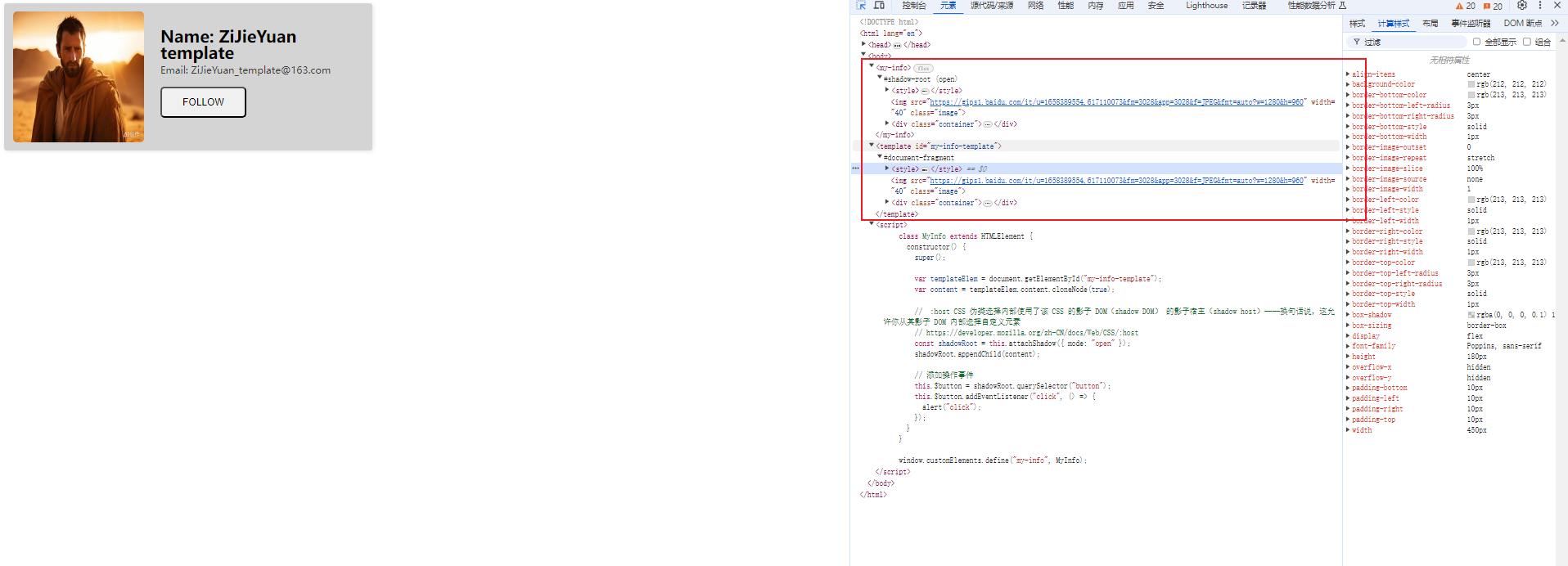Web Component
官方解释
- Web Component 是一套不同的技术,允许你创建可重用的定制元素(它们的功能封装在你的代码之外)并且在你的 web 应用中使用它们
Js 自定义标签
html
<!DOCTYPE html>
<html lang="en">
<head>
<meta charset="UTF-8" />
<meta name="viewport" content="width=device-width, initial-scale=1.0" />
<title>Document</title>
</head>
<body>
<my-info></my-info>
</body>
<script>
class MyInfoTag extends HTMLElement {
constructor() {
super();
var image = document.createElement("img");
image.src =
"https://gips1.baidu.com/it/u=1658389554,617110073&fm=3028&app=3028&f=JPEG&fmt=auto?w=1280&h=960";
image.width = 40;
image.classList.add("image");
var container = document.createElement("div");
container.classList.add("container");
var name = document.createElement("p");
name.classList.add("name");
name.innerText = "Name: ZiJieYuan";
var email = document.createElement("p");
email.classList.add("email");
email.innerText = "Email: ZiJieYuan@163.com";
var button = document.createElement("button");
button.classList.add("button");
button.innerText = "Follow";
container.append(name, email, button);
this.append(image, container);
}
}
window.customElements.define("my-info", MyInfoTag);
</script>
</html><template>标签
- 使用 JavaScript 写上一节的 DOM 结构很麻烦,Web Components API 提供了
<template>标签,可以在它里面使用 HTML 定义 DOM
html
<!DOCTYPE html>
<html lang="en">
<head>
<meta charset="UTF-8" />
<meta name="viewport" content="width=device-width, initial-scale=1.0" />
<title>Document</title>
</head>
<body>
<my-info></my-info>
<template id="my-info-template">
<style>
:host {
display: flex;
align-items: center;
width: 450px;
height: 180px;
background-color: #d4d4d4;
border: 1px solid #d5d5d5;
box-shadow: 1px 1px 5px rgba(0, 0, 0, 0.1);
border-radius: 3px;
overflow: hidden;
padding: 10px;
box-sizing: border-box;
font-family: "Poppins", sans-serif;
}
.image {
flex: 0 0 auto;
width: 160px;
height: 160px;
vertical-align: middle;
border-radius: 5px;
}
.container {
box-sizing: border-box;
padding: 20px;
height: 160px;
}
.container > .name {
font-size: 20px;
font-weight: 600;
line-height: 1;
margin: 0;
margin-bottom: 5px;
}
.container > .email {
font-size: 12px;
opacity: 0.75;
line-height: 1;
margin: 0;
margin-bottom: 15px;
}
.container > .button {
padding: 10px 25px;
font-size: 12px;
border-radius: 5px;
text-transform: uppercase;
}
</style>
<img
src="https://gips1.baidu.com/it/u=1658389554,617110073&fm=3028&app=3028&f=JPEG&fmt=auto?w=1280&h=960"
width="40"
class="image"
/>
<div class="container">
<p class="name">Name: ZiJieYuan template</p>
<p class="email">Email: ZiJieYuan_template@163.com</p>
<button class="button">Follow</button>
</div>
</template>
</body>
<script>
class MyInfo extends HTMLElement {
constructor() {
super();
var templateElem = document.getElementById("my-info-template");
var content = templateElem.content.cloneNode(true);
// :host CSS 伪类选择内部使用了该 CSS 的影子 DOM(shadow DOM) 的影子宿主(shadow host)——换句话说,这允许你从其影子 DOM 内部选择自定义元素
// https://developer.mozilla.org/zh-CN/docs/Web/CSS/:host
const shadowRoot = this.attachShadow({ mode: "open" });
shadowRoot.appendChild(content);
// 添加操作事件
this.$button = shadowRoot.querySelector("button");
this.$button.addEventListener("click", () => {
alert("click");
});
}
}
window.customElements.define("my-info", MyInfo);
</script>
</html>
